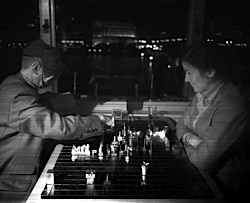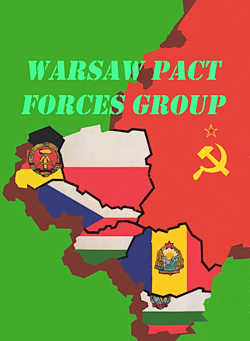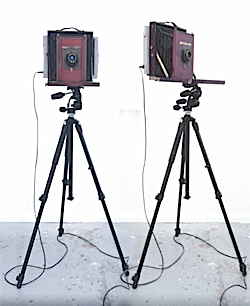French Connection Friday Late: Cold War Modern
Friday, 31 October 2008, 6.30-10pm
V&A South Kensington, Cromwell Road London SW7 2RL
www.vam.ac.uk/fcfridaylate
FREE
Nearest Tube: South KensingtonJoin us for an evening to celebrate the exhibition, Cold War Modern: Design 1945–1970.Cybersonica and Cybersalon with Fashion in Film and the London Games Fringe showcase an evening of progressive electronic music and audiovisual performance, accessible interactive and digital art, thought-provoking screenings and classic and contemporary gaming. Become an activist and nurture your revolutionary streak with Class Wargames who will be on hand to help you fight and win against the oppressors of spectacular society! - Cold War Live & Direct – a live audiovisual entertainment channel tuned to the Cold War era featuring Secret Films, I Am The Mighty Jungulator and Ben Osborne and Overlap presenting Baby Space Disco (Noise of Art)
- A new interactive work by Squidsoup – The Stealth Project: Under The Radar – incorporating NOVA, the world’s first full-colour real 3D LED video screen.
- Adolescent nostalgia and political critique with redeveloped and DIY ‘board games of war’ from Class Wargames & Kiss Kiss Bang Bang featuring players from the Warsaw Pact Forces Group.
- Take centre stage and become iconic characters from three great Cold War Film Classics with The Casting Scene‘s online ‘audition’ service.
- Shelley Parker‘s emotive and atmospheric soundscape – Cast – evokes a post-apocalyptic future in the awe-inspiring grandeur of the V&A’s Cast Courts.
- The London Games Fringe load up and invite you to play three classic Cold War themed video games: Missile Command, Defcon and the multiplayer GoldenEye 007.
- Fashion in Film presents Beyond Espionage – a selection of some of the most eloquent newsreels and documentaries from post-war East Germany and Czechoslovakia exploring the rhetoric of “socialist fashion”.
- Alex Veness and his custom-made camera the Xenon-Eye create grotesque, bizarrely misshapen, anxious Imaginary Cold War Portraits.
- Stanza‘s Robotica: Control Inside the Panopticon is a playful installation that questions ideas of surveillance and tracking using robots, CCTV and sensor technologies.
- and Stanza‘s Sensity V&A uses a network of ‘motes’ around the V&A to collect data and drive a visualisation that reflects the ’emotional state’ of the building.
In detail:Cold War Live & Direct
Grand Entrance
18.30-21.45Three distinctive audiovisual outfits perform live sets that collage and recontextualise Cold War events and themes. 18.30-20.00 – Secret Films
<myspace.com/thesecretchannel> Secret Films explore the mechanics of film and film genres, dislocating them from each other and bending our familiar conceptions of them. Exploring interrogation and surveillance techniques of the Cold War by way of appropriated film & video, Secret Films create a new paranoid narrative for this period in our history remixing the sounds, pictures and newsreels of the era. 20.00-20.30 – I Am The Mighty Jungulator
<www.iamthemightyjungulator.com/band>
<www.myspace.com/iamthemightyjungulator> I Am The Mighty Jungulator extend the parameters of live sample processing using the generative potency of their audio engine – the Jungulator – while mixing this with live musicians to form a rare electro-acoustic interplay of analogue and digital to create glistening electronic textures. For Friday Late at the V&A they’ll be refining and presenting a cinematic live set of their existing “Culture Crunch” material of found footage from TV screens and public information films of the 50s and 60s along with their “icon town“ footage made up from examples of infrastructure iconongraphy from various public arenas (airports, hospitals, government buildings etc.) from all around the world from the cold war period. 20.30-21.45 – Ben Osborne and Overlap presents Baby Space Disco (Noise of Art)
<www.myspace.com/noiseofart> In the 1970’s electronic music pointed to a future form of music on both sides of the iron curtain. Ben Osborne’s disco set will begin with rare Seventies electronic tracks from both sides of the eastern block, while the visuals will be made up of unique Soviet era space footage from the BFI archive. The film includes the first Sputnik, the first space walk and cosmonaut training from an era when the USSR was winning the space race. The visuals will be mixed live by art duo, Overlap. Brief interludes between performances will feature short films showing Cold War themed output of the Engine – a piece of software structured around the processes inherent in photography, painting and programming designed by Daniel Hirschmann <www.plankman.com> – a South Africa born artist who uses technology to realise his artistic practice. The Stealth Project: Under The Radar (visualised in NOVA space)
Gamble Room – Cafe
18.30-21.45<www.squidsoup.org/stealth> Planes, missiles and other hardware that deflect or otherwise avoid radar detection were key in the race for world supremacy. Detection avoidance, or stealth technology, was one of many ‘developments’ to emerge from the Cold War. In this new interactive work, two grids of triggers target and launch missiles across an abstracted 3D space at each other, attempting to avoid radar detection and annihilate the opposition! However, in contrast to the Mutually Assured Destruction madness of the arms race, the piece acts as a collaborative spatial musical instrument – each ‘missile’ emits sounds based on its relative position and the conditions it encounters along its trajectory. The physical centrepiece of this work is the Baby NOVA, the world’s first full-colour real 3D LED (light emitting diodes) video screen conceived to visualize scientific data dynamically in three dimensions. NOVA is modular and expandable – a NOVA system installed at Zurich’s main train measures 5 x 5 x 1m and consists of 25,000 points of light in 3D space. The Stealth Project – by Squidsoup, in collaboration with ETH Zurich and horao GmbH.
Based on research part funded by the Arts Institute at Bournemouth, and with additional support from University of Wales, Newport. The Stealth Project © Squidsoup.org 2008
NOVA ©ETH Zurich, horao GmbH 2006-2008 Class Wargames
Sculpture Gallery 24
18.30-21.45<www.classwargames.net>
<www.wpfg.org.uk> By developing their own versions of the game and playing Situationist International leader Guy Debord’s The Game of War in public Class Wargames show how revolutionary activists could learn how to fight and win against the oppressors of spectacular society! Copplestone Castings presents Kiss Kiss Bang Bang, a DIY board-game with miniatures featuring secret agents and super villains – shaken, not stirred. Includes My Missile’s Bigger Than Yours – a top secret US nuclear missile silo has been seized by the Evil Genius Obermass and his boiler-suited minions. Amongst the players will be members of the Warsaw Pact Forces Group – a non-political living history group, keen collectors of Warsaw Pact militaria and students of the history of the Communist bloc nations 1955 to 1991. The Casting Scene: Cold War Film Classics
Lecture Theatre – auditions
Sackler Centre Reception – audition review suite
18.30-21.45<www.thecastingscene.com> Take centre stage with thecastingscene.com in a specially designed ‘casting booth’ and ‘audition’ online as an iconic character from three great Cold War film classics: Michael Caine’s Harry Palmer from The Ipcress File; Sean Connery’s iconic Bond and Ursula Andress’ Honey Ryder from Dr No; and Francoise Dorleac’s Anya from Billion Dollar Brain. Auditions captured using web cams and laptops, will be relayed to the ‘audition review suite’ in the Sackler Centre Reception in real-time. The Casting Scene is the new online casting service for the entertainment industries that brings producers with film and TV projects together with actors looking for roles. Producers simply post an extract from their script online and actors upload a webcam audition. Casting Scene’s unique online filtering system brings the best auditions to the attention of the producers who then decide who to shortlist. Fast, simple, easy to use, Casting Scene saves time and cuts out pointless journeys by being entirely online. ‘Coming soon to a screen in front of you’, this is a new service that will revolutionise the way that the entertainment industries search for and cast talent. Shelley Parker: Cast
The Cast Courts 46a
18.30-21.45<www.shelleyparker.co.uk> Shelley Parker, a London based artist working with sound/music/image, creates an emotive and atmospheric soundscape of field recordings and sounds which responds to the notions of myth, religion and authenticity inferred by the casts to evoke a feeling of post-apocalyptic future in the awe-inspiring grandeur of the V&A’s Cast Courts. London Games Fringe: Cold War Games
Silver Study Area
18.30-21.45<www.londongamesfringe.com> London Games Fringe load up three classic Cold War themed video games: Missile Command, Defcon and the multiplayer GoldenEye 007. Missile Command is a stark yet compelling 1980 arcade game produced by the US company Atari which reflects the era’s concerns about atomic conflict. Players defend their cities from incoming nuclear warheads until being eventually overwhelmed. Our set-up showcases the game’s unique-for-its-time “Trackball“ target control system. Defcon is a PC strategy game and nuclear war simulation created by independent UK developers Introversion Software. Taking its name from the “Defense Condition” measure of the activation and readiness level of the US Air Force the main display takes the form of a retro-style vector graphics map of global military activity familiar from films such as Dr. Strangelove, Fail-Safe, and WarGames. GoldenEye 007 is an acclaimed 1997 James Bond-themed console game developed by the British company Rare and broadly based on the 1995 film GoldenEye but including bonus levels inspired by a number of other Bond movies. Our version is displayed on the Nintendo 64 console in its easiest-to-pick-up 4-player multiplayer mode. Part of the London Games Fringe – a festival of alternative gaming events at the end of October 2008, organised by artists, academics, gamers, game developers, educators and creative professionals from a wide range of different media. Fashion in Film presents: Beyond Espionage: Fashion Under Socialism
National Art Library
19.00-21.45
Looped, approximate running time 18 minutes<www.fashioninfilm.com> Fashion under socialism was essentially an anti-fashion: anti-capitalist and anti-consumerist. As a “clothing culture“ it was supposed to aid the “all-round development of the socialist personality”. Yet, the clothing produced within a centrally planned economy often didn’t fit the desires. This selection of some of the most eloquent newsreels and documentaries from post-war East Germany and Czechoslovakia explores the rhetoric of “socialist fashion“. From displays of restrained modernist taste to the majestic International Fashion Congresses, fashion espionage and the mockery of “Western“ extravagance, this programme reveals complex issues and tensions, showing fashion as a key player in the Cold War propaganda. Curated by Renate Stauss and Marketa Uhlirova, with thanks to Progress Film-Verleih GmbH and Kratky Film Praha and presented in association with Central Saint Martins and BFI Southbank. Alex Veness: Imaginary Cold War Portraits
Grand Entrance
20.15-21.45<www.alexveness.net> Developed by Alex Veness, Xenon-Eye is a unique, custom-built and a new type of camera that combines analogue and digital technologies. Xenon-Eye creates photographs with a radically new form and it’s unique method of recording images makes it highly interactive. In Imaginary Cold War Portraits, Alex uses the Xenon-Eye to create grotesque, bizarrely misshapen, anxious portraits. Xenon-Eye’s often malicious, paranoid images evoke sensibilities of fear and individuation and can easily be imagined as scenes from the nightmares of absolute destruction suffered by billions of people during the Cold War. At French Connection Friday Late, Xenon-Eye will start the evening by documenting the Class Wargames collective as they play Guy Debord’s Game Of War. Following that, Xenon-Eye will relocate to the Main Entrance where consenting visitors and event participants can have their portrait taken. These Imaginary Cold War Portraits will feature on the screen in the Main Entrance throughout the evening and an A4 printer will be available to make prints for sitters to keep as a personal document. Stanza: Robotica – Control Inside the Panopticon
Gallery 47f (tbc)
18.30-21.45<www.stanza.co.uk> The idea of the Panopticon originated with the English utilitarian philosopher Jeremy Bentham – as a prison design that would allow an observer to monitor all the prisoners at all times without any prisoner being aware of whether he was being monitored or not. Twelve robots – each identified with a prison inmate number – roam freely on a canvas on the floor. These robotic prisoners are sent out across the canvas with small tasks to complete. Police “barrier tape” keeps the robots inside their controlled space. The robots are tracked – everything is watched and recorded since each robot wears a wireless CCTV camera – and shown on a monitor as a record of the event. Like people, robots have common ‘modes’ and can be programmed to demonstrate social behaviour. The robots mimic and trace the patterns people make based on algorithms – but unlike people their movements can be networked into retrievable data structures that it can be re-imagined and sourced for information. The digital patterns of the robots are re-made as analogue patterns. The robot path is in effect replaced with a series of ‘brushes’ – and it is these that are wandering around the canvas. Their “wanderings” over the evening are captured onto the canvas. They create their own robotic generative paintings in their own little prison. Stanza: Sensity V&A
Grand Entrance
18.30-21.45<www.stanza.co.uk> Sensity artworks are made from data collected across the city using ‘motes’ – tiny wireless sensor boards that gather data and then use custom software to communicate with one another in real-time across a network via a central server. The motes sense the micro incidents of change in the weather, the noise, traffic flows and people flows. Sensity uses this data to turn the world is a dynamic real time artwork – mirroring the city data space in an emergent series of generative artworks and a public domain data archive. These works are in effect emergent social sculptures visualizing the emotional state of the city. For Friday Late at the V&A Stanza sited a network of ‘motes’ around the V&A to collect data – but in advance of the event itself. This data will drive a visualisation that reflects the ’emotional state’ of the V&A – but with a temporal shift. Also on at the V&A:Cold War Modern: Design 1945-1970
25 September 2008 -11 January 2009
Buy tickets at the Information Desk, last entry 21.00 The first exhibition to explore international developments in modern art, design, architecture and film in the context of the Cold War. Fashion V Sport
Porter Gallery, Room 48a
Buy tickets from the Information Desk, last entry 21.00 | 


















